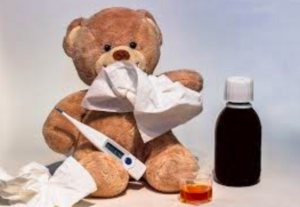How do I treat my child’s fever at home?
Treat your child’s fever at home
How to use natural home remedies for treating fevers
It’s that time of year when colds and fevers are happening. They can sure be uncomfortable, but before you run to the Doctor, learn more about what causes a fever and how you can treat your child’s fever at home.

Did you know that many of the symptoms we feel when we’re sick is not because of the invading virus or bacteria? It’s our own immune system defending us! Fevers, for instance, are one of the strongest immune reactions your body has to defend itself.
Normal body temperature to support optimal function is ideally around 98.6 °F (37°C), plus or minus about 0.3°F (0.17°C). However, fevers occur when the body temp rises above this, 1-4 degrees above the normal body temp.
In both children and adults, fevers are most commonly a natural reaction to infection.
When an infectious “micro-organism” stimulates white blood cells, a substance is released that signals the body to increase its temperature. The body generates heat by increasing its metabolism or shivering. In addition, heat loss is minimized in the body by restricting blood flow to the skin, giving it a pale appearance. As the temperature rises, the skin flushes, and you may start to sweat. You may also lose your appetite and feel lethargic, achy and sleepy. In newborns, these other symptoms may occur before they generate a fever.
A basic fever can be thought of as the immune system working at its best as this is nature’s way of fighting an infection.
There are many purposes of a fever:
- The temperature has specific functions:
– 37°C (98.6°F) Normal body temperature
– At 39.5°C (103.1°F) Bacteriostatic (Stops the microbes from growing)
– At 40.5°C (104.9°F) Bacteriolytic (Kills microbes and is the best antibiotic)
– At 42°C (107.6°F) Cellulolytic (Kills cells in the body) - Stimulate Thyroid: Helps to eliminate toxins, speeds up metabolism
- Increase Circulation: Increased respiratory and heart rates will increase blood flow
- Increase Liver Activity:
a. Mechanically, the liver is stimulated with breathing faster, the motion of the diaphragm pushes on the liver, increasing the circulation within it and the increased heat leads to increased elimination
b. There is an increase in the production of proteins so the body can make more molecules to support immunity - Helps Kills Microbes: A mild fever increases white blood cells (immune cells) that kill cells infected with viruses, bacteria, fungi, and cancer. It also improves the destruction of bacteria and impairs the replication of many bacteria and viruses.
The effective temperature range for a fever is 39°C to 40.5°C (102.2°F to 104.9°F).
As seen above, there are many benefits to fever. That is why it is best not to decrease or suppress the fever with acetaminophen (Tylenol or Tempra) or Ibuprofen (Advil).
If caring for a child with a fever, the key is to watch them and make sure they do not get dehydrated.
 The fever is too high if your child flops like wilted flowers, their eyes are rolling or their mouth is sagging or dry. In extreme and rare cases, your child may have a febrile seizure. The seizure may look scary, but there has been no evidence that they cause permanent damage. Ensure that if any of the above severe situations occur, your child is looked at by your ND, MD or taken to the ER. If dehydration is severe, you may have to take your child to the ER in order to become re-hydrated.
The fever is too high if your child flops like wilted flowers, their eyes are rolling or their mouth is sagging or dry. In extreme and rare cases, your child may have a febrile seizure. The seizure may look scary, but there has been no evidence that they cause permanent damage. Ensure that if any of the above severe situations occur, your child is looked at by your ND, MD or taken to the ER. If dehydration is severe, you may have to take your child to the ER in order to become re-hydrated.
Some strategies to help avoid complications and treat a fever at home:
- Ensure your child stays hydrated. They may not be hungry, but make sure they are drinking
fluids – preferably water (remember – water is nature’s juice as Dr. Chris Bjorndal, ND loves to say!), bone or vegetable broth, other clear non-creamy broths, spring water and herbal teas (chamomile, ginger, peppermint, licorice root). Endurlyte is an electrolyte powder available at the clinic can be added to the water. For a breastfeeding child, ensure they are nursing as often as they can while mom drinks the teas and soups. - If necessary, you can do the following to help decrease the temperature:
a. sponge your child with warm water
b. give them a tepid bath or
c. place a cool/tepid cloth on their forehead and the back of their neck - If the temperature is still rising uncomfortably high, then you can use Apple Cider Vinegar and swab it down the spine and the bottom of the child’s feet.
- If the Apple Cider Vinegar is not working, you can use a very cold, wet hand towel and wrap your child’s arm and opposite leg (ie right arm and left leg). Then bundle them up in a blanket and get them to drink or sip fluids or ice cubes. This allows the blood to cool down, but prevents a chill. Leave them for 3 to 5 minutes, and then dry them off, and wrap them in a blanket and monitor their temperature. You may have to repeat with the opposite limbs, and keep alternating this technique.
- To help your child clear the toxins, and enable the lymph system to be at its best, you can pump the lymph system and/or use a lymph cream. The pumping is very gentle motion with a pressure similar to a massage. Dr. Chris also recommends incorporating massage therapy and chiropractic care to your health care team, in addiction to working with a Naturopathic doctor.
Most fevers are natural and helpful and nothing to be afraid of.
Only when they are prolonged, extremely high, or accompanied by flopping or severe dehydration should there be a concern. The most helpful thing is to know when fevers are good and when to take action to bring it down, and to remember that most fevers are here to help your child fight off the invading microbes!



